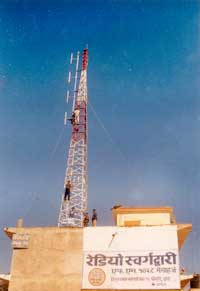 One year after it started broadcasting, Dang's first and only community radio, Swargadwari FM 102.8, has already become a fixture in every home in this conflict-torn district.
One year after it started broadcasting, Dang's first and only community radio, Swargadwari FM 102.8, has already become a fixture in every home in this conflict-torn district. The station is functioning as a true public service broadcaster, with news people can use, information relevant to their daily lives and with music and religious programs that promote peace and compassion. Last month, Swargadwari (the name means "heaven's gate" after an ashram in Pyuthan) was the local host for the Travelling Peace Concert which saw a record-breaking 60,000 people flocking to Tulsipur to listen to famous Nepali singers.
Its Shanti Abhiyan (Campaign for Peace) program present discussions on conflict resolution, peace building with studio guests, and is rebroadcast from Kathmandu's Sagarmatha FM. Other programs include Sanjavani (Elixir of life) and Saha-astitwa (Coexistence) which are aimed at raising the status of women.
The fact that Swargadwari has survived even a year in the polarised and tense atmosphere during the worst part of the insurgency in the heartland of the conflict is already proof of the power of its message. The station's listeners include villagers, local civil service and even the Maoists. "Swargadwari gives the most authentic and reliable news," wrote one anonymous Maoist listener from neighbouring Rolpa. During the emergency, the Maoists cadre depended heavily on Swargadwari and the BBC Nepali Service for news of what was happening in the country, according to KL Peedit, ex-editor of the now-banned Jana Ubhar weekly.
One indication of the popularity of the station is the soaring sales of FM radio sets in Dang district. Retailers of tiny Chinese and Indian made FM sets in Ghorahi and Tulsipur bazar can barely meet the demand. Durgesh Yogi, a health worker who also owns a radio shop, says, "Since Swargadwari came along, radio sets have been selling like hot cakes. It's good for business." Scratchy broadcasts from Radio Nepal are being replaced by the clarity and rising popularity of Swargadwari.
 However, the station which is named after a popular ashram in Pyuthan, cannot survive from commercials and depends on grants from donors. Listenership is estimated at 700,000 in Dang and parts of Salyan, Rolpa, Pyuthan and Banke. Once its transmission capacity is increased to 300 watts listeners as far away as Nepalganj will be able to access the station.
However, the station which is named after a popular ashram in Pyuthan, cannot survive from commercials and depends on grants from donors. Listenership is estimated at 700,000 in Dang and parts of Salyan, Rolpa, Pyuthan and Banke. Once its transmission capacity is increased to 300 watts listeners as far away as Nepalganj will be able to access the station. Listenership zoomed after Swargadwari started relaying newspaper headlines from Radio Sagarmatha in Kathmandu at 6AM. This program now has the highest ratings. The management at Swargadwari FM encourages local artists, and does not feature any Hindi or English songs. This has resulted in a surge of singers and musicians recording their songs in the FM-compatible digital format. They are churning out folk, modern and pop songs not just in Nepali but in regional dialects as well.
The station has special programs for Dang's indigenous Tharu people. Said one elderly Tharu farmer: "It's wonderful to hear our own language directly relate to our day-to-day life. We learn so many things, from improving crops to health tips."
Station manager Dadhiram Subedi (pic, above), who switched from to broadcasting after 15 years as a print journalist, told us, "We were very concerned about the Tharus who have been marginalised for so long. Our sole objective is to inform, educate and entertain people living in this part of the country. FM has won the people's trust by being reliable with news, and not being a purely commercial station."
Despite the immense popularity of Swargadwari FM-judging from the deluge of heart-warming letters from listeners-the station is plagued by problems like the lack of local and national level advertisers, initial threats from the Maoists, and lack of stand-by broadcasting equipment. Subedi doesn't mind admitting that Swargadwari is deep in the red despite all staff being voluntary. But he is not worried, "It is not easy, but our popularity means that we are in it for the long haul."


